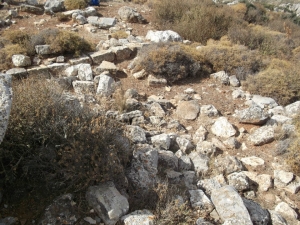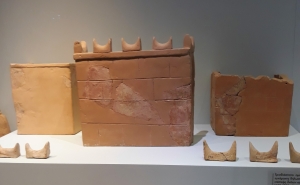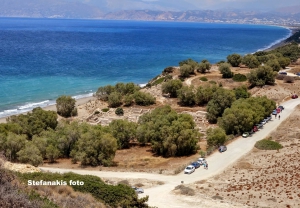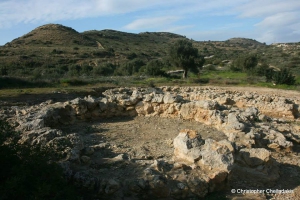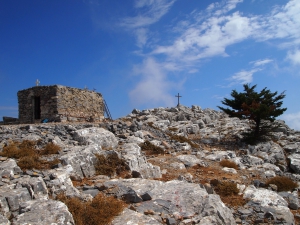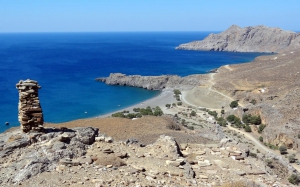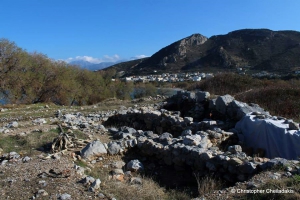West of the village Tylisos in Malevizi province rises the mount Pirgos with its peak reaching an altitude of 684m. In this steep peak the archaeologist Stylianos Alexiou in 1963 identified one of the most important Minoan Peak Sanctuaries of Central Crete. Religious figurines and stone horns were found, and a rectangular building measuring 13m x 4.50m came to light. It can be reached by walking about 20 minutes from the nearest parking area that is reached by a rural road.
- Location: Heraklion Prefecture
- Type: Peak Sanctuary
- Accessibility: Walking
- Peak Period: Minoan Era (3000 BC-1200 BC)
The hill Katrinia in the area of Piskokefalo, province Sitia, hosted one of the most important peak sanctuaries of Minoan Crete, where pilgrims from the surrounding areas came to praise their deities and devote their tributes. Three sacred caves have been identified in the same area, just like in other peak sanctuaries in Crete (e.g. Giouchtas, Pirgos near Tylissos, etc.).
- Location: Lassithi Prefecture
- Type: Peak Sanctuary
- Accessibility: Dirt track
- Peak Period: Minoan Era (3000 BC-1200 BC)
The archaeological site of Kommos is located 4km west of Phaestus, near Pitsidia and Matala. Kommos (or Komos) was a small Minoan town founded in 2000BC and served the port needs of Phaestus, with which it was linked by road. Kommos was probably destroyed by an earthquake in 1700BC, but survived up to the Hellenistic period.
- Location: Heraklion Prefecture
- Type: Ancient Settlement
- Accessibility: Paved road
- Peak Period: Minoan Era (3000 BC-1200 BC)
The historic Monastery of Odigitrias on the way to Agiofaraggo hides many treasures. Beyond the monastery itself with such great history and the tower of Xopateras, it conceals another surprise north of the monastery. This is the prepalatial necropolis of Odigitria, named after the monastery, as we still don’t know the name of the town it belonged to.
- Location: Heraklion Prefecture
- Type: Tombs
- Accessibility: Paved road
- Peak Period: Minoan Era (3000 BC-1200 BC)
Kofinas is the highest peak in the wild Asterousia Range with an altitude of 1231m and gets its name from its shape resembles an inverted basket (kofini in Greek). The top, with stunning views to the Libyan Sea, today hosts a temple of the Holy Cross (Timios Stavros), celebrating on September 14.
- Location: Heraklion Prefecture
- Type: Peak Sanctuary
- Accessibility: Walking
- Peak Period: Minoan Era (3000 BC-1200 BC)
On the rocky hill Papouri, located northeast of the beach of Tripiti, high above the tavern, we meet the remains of a Minoan settlement. The first excavations were made in 1986-88 by archeologist Antonis Vasilakis. A vaulted tomb of 2800-2000BC was also been found 200m on the south.
- Location: Heraklion Prefecture
- Type: Ancient Settlement
- Accessibility: Walking
- Peak Period: Minoan Era (3000 BC-1200 BC)
The Minoan mansion of Sklavokambos was discovered in 1930, while constructing the main road to Anogia and part of it was destroyed by the works. It is a multiple-story building with a main room where a clay ox head was found, along with a Late Minoan IB period style jug and a stone rhyton. The building had at least 17 rooms.
- Location: Heraklion Prefecture
- Type: Ancient mansion
- Accessibility: Paved road
- Peak Period: Minoan Era (3000 BC-1200 BC)
Priniatikos Pirgos is a small peninsula that separates the two beaches of Agios Panteleimon Karavostasis upon which an important Minoan settlement has been identified. The settlement has been mapped by the American and Irish Archaeological School. It was inhabited from the Minoan till the Ottoman Era and was highly depended on its harbor. Important findings are kilns for ceramics production.
- Location: Lassithi Prefecture
- Type: Ancient Settlement
- Accessibility: Walking
- Peak Period: Minoan Era (3000 BC-1200 BC)










